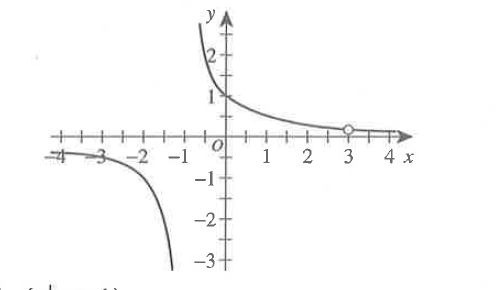If f(x)=x+2(x+2)(x2−4), its graph will have
one horizontal and three vertical asymptotes
one horizontal and two vertical asymototes
one horizontal and one vertical asymptote
zero horizontal and one vertical asymptote
The correct Answer is:C
To determine the asymptotes of the function f(x)=x+2(x+2)(x2−4), we will follow these steps:
Step 1: Simplify the Function
First, we can simplify the function by factoring the denominator.
The denominator x2−4 can be factored as:
x2−4=(x−2)(x+2)
Thus, we can rewrite f(x):
f(x)=x+2(x+2)(x−2)(x+2)
Now, we can cancel the (x+2) term from the numerator and denominator (noting that x≠−2):
f(x)=1(x−2)(x+2)
Step 2: Identify Vertical Asymptotes
Vertical asymptotes occur where the denominator is zero (provided the numerator is not also zero).
Setting the denominator equal to zero:
(x−2)(x+2)=0
This gives us:
x−2=0⇒x=2
x+2=0⇒x=−2
Thus, we have vertical asymptotes at x=2 and x=−2.
Step 3: Identify Horizontal Asymptotes
To find horizontal asymptotes, we look at the behavior of f(x) as x approaches infinity.
As x approaches infinity, the function simplifies to:
f(x)≈1x2(since the leading term dominates)
As x→∞ or x→−∞, f(x)→0.
Thus, there is a horizontal asymptote at y=0.
Conclusion
In summary, the function f(x) has:
- Vertical Asymptotes at x=2 and x=−2.
- Horizontal Asymptote at y=0.
Therefore, the correct answer is Option B: one horizontal and two vertical asymptotes.
First, we can simplify the function by factoring the denominator.
x2−4=(x−2)(x+2)
Thus, we can rewrite f(x):
f(x)=x+2(x+2)(x−2)(x+2)
Now, we can cancel the (x+2) term from the numerator and denominator (noting that x≠−2):
f(x)=1(x−2)(x+2)
Vertical asymptotes occur where the denominator is zero (provided the numerator is not also zero).
(x−2)(x+2)=0
This gives us:
x−2=0⇒x=2
x+2=0⇒x=−2
Thus, we have vertical asymptotes at x=2 and x=−2.
To find horizontal asymptotes, we look at the behavior of f(x) as x approaches infinity.
f(x)≈1x2(since the leading term dominates)
As x→∞ or x→−∞, f(x)→0.
In summary, the function f(x) has:
- Vertical Asymptotes at x=2 and x=−2.
- Horizontal Asymptote at y=0.
Topper's Solved these Questions
Similar Questions
Knowledge Check
If f(x)=3x2−2x+4,f(−2)=
A−12B−4C−2D20If f(x)=x−2x2−4 for what value(s) of x does the graph of f(x) have a vertical asymptote?
A−2,0,and2B−2and2C2D−2If f(x)=x−7x2−49, for what value(s) of x does the graph of y=f(x) have a vertical asymptote?
A−7B0C−7,0,7D−7,7
Draw and graph of f(x)=4logexx2. Also find the range.
View SolutionIf f(x)={|x|−|x−1|}2, draw the graph of f(x) and discuss its continuity and differentiability of f(x)
View SolutionThe graph of f(x)=x−3x2−2x−3 is shown below. What is the domain of f(x) ?

View SolutionIf f(g(x))=4x2−8xandf(x)=x2−4, then g(x)=
View SolutionSuppose f(x)=12x2−8 for −4≤x≤4. Then the maximum value of the graph of |f(x)| is
View Solution
